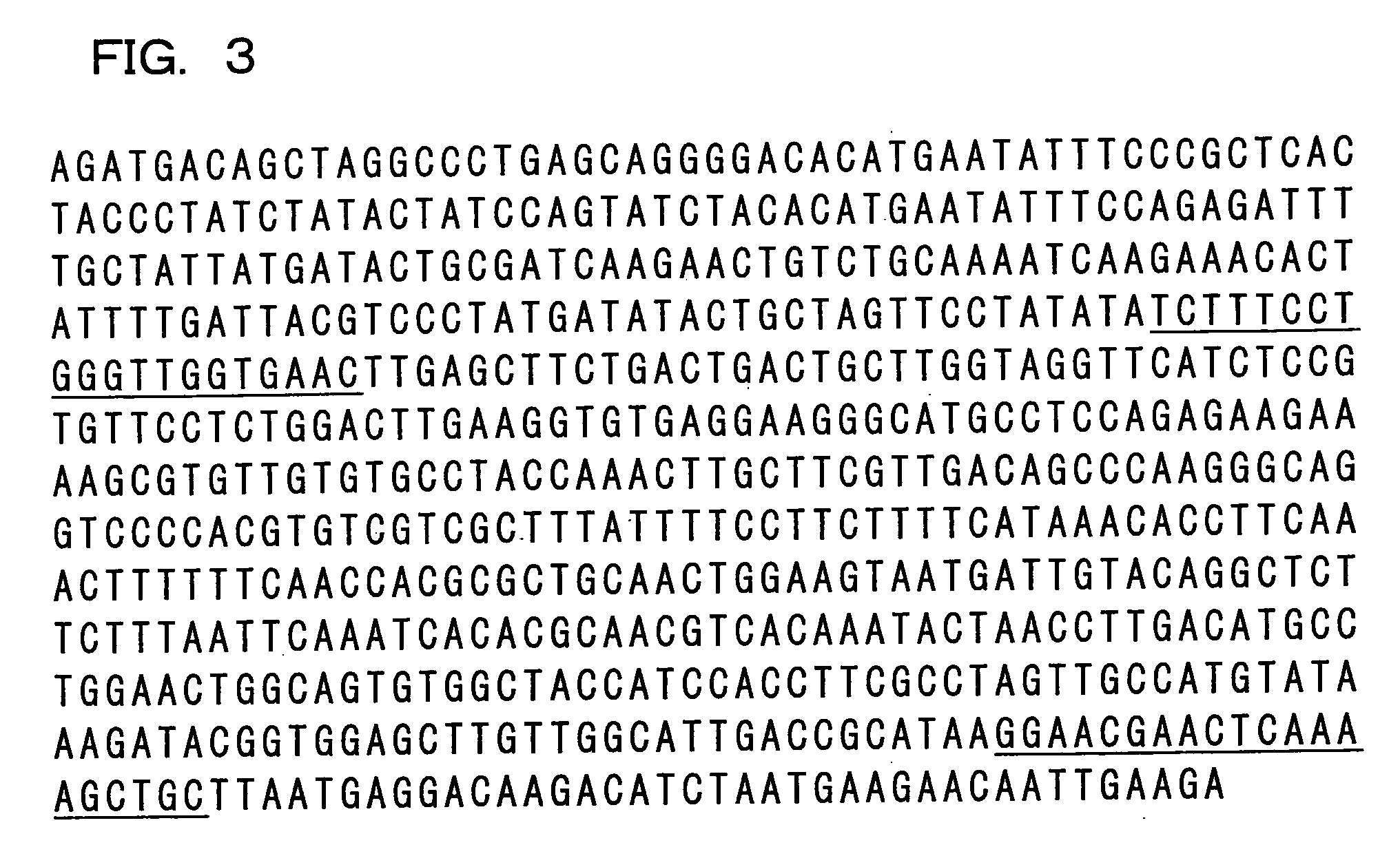Genetic marker linked to gene locus involved in barley resistance to yellow mosaic disease and use thereof
- Summary
- Abstract
- Description
- Claims
- Application Information
AI Technical Summary
Benefits of technology
Problems solved by technology
Method used
Image
Examples
example 1
QTL Analysis on Barley Resistance to Yellow Mosaic Disease
[0233]As the algorithms of QTL analysis, simple interval mapping (“SIM” hereinafter) and composite interval mapping (“CIM” hereinafter) were used. As the analysis software, MAPMAKER / QTL and QTL Cartographer were used, respectively. The threshold of LOD score was set to 2. For an LOD score exceeding 2, the presence of a QTL was estimated at a position between two markers where the LOD score was the greatest.
[0234][Results]
[0235]Tables 1, 2, and 3 show the results for the DHHS population, RI1 population, and RI2 population, respectively. In Tables 1 through 3, “Population” denotes the name of a population subjected to the QTL analysis, “Trait” means characteristic, “Chromosome” means the chromosome on which the genetic markers are located, “Marker interval (M1-A-QTL-B-M2)” means two genetic markers flanking a QTL in the vicinity thereof, “Distance (cM) A+B” means the distance between two genetic markers flanking a QTL, “Positio...
example 2
Detection of Genetic Marker FEggaMtgg116
[0251](Method)
[0252]The genomic DNA (50 ng) of tested barley was double digested at 37° C. for 12 hours in a 25 μl reaction system including 1.5 U of EcoRI (TAKARA BIO INC.) and 1.5 U of MseI (NEW ENGLAND BioLabs). After the restriction enzyme treatment, the DNA was ligated at 37° C. for 3 hours to 5 μM EcoRI adapter (base sequences of SEQ ID NO: 49 and 50) and 50 μM MseI adapter (base sequences of SEQ ID NO: 47 and 48), using 25 U T4 ligase (TAKARA BIO INC.). The DNA fragments after ligation were pre-amplified with a universal primer for EcoRI (base sequence of SEQ ID NO: 52) and a universal primer for MseI (base sequence of SEQ ID NO: 51). For 0.07 mg / ml of pre-amplification reaction solution, an amplification reaction (final amplification) was performed with a selective primer for EcoRI (base sequence of SEQ ID No: 36) and a selective primer for MseI (base sequence of SEQ ID No: 35). For the amplification, TaKaRa Ex Taq (TAKARA BIO INC.) wa...
example 3
Detection of Genetic Marker FEgggMcaa585
[0259]The methodology of Example 2 was used except that the amplification reaction (final amplification) was performed with selective primer for EcoPI (base sequence of SEQ ID NO: 38) and selective primer for MseI (base sequence of SEQ ID NO: 37).
[0260](Results)
[0261]FIG. 13 shows the result of electrophoresis performed on the amplified fragments of the amplification reaction. In FIG. 13, the leftmost and rightmost lanes show size markers. The second lane from the left shows the result of AFLP detection on Russia 6, which is a barley variety resistant to yellow mosaic disease. The third lane from the left is the result of AFLP detection on H.E.S. 4, which is a barley variety susceptible to yellow mosaic disease. The other lanes are the results of AFLP detection on the RI1 population of inbred lines (RI lines) obtained from the cross between Russia 6 and H.E.S. 4.
[0262]The results shown in FIG. 13 revealed that the amplified fragments obtained ...
PUM
| Property | Measurement | Unit |
|---|---|---|
| Fraction | aaaaa | aaaaa |
| Fraction | aaaaa | aaaaa |
| Fraction | aaaaa | aaaaa |
Abstract
Description
Claims
Application Information
 Login to View More
Login to View More - R&D
- Intellectual Property
- Life Sciences
- Materials
- Tech Scout
- Unparalleled Data Quality
- Higher Quality Content
- 60% Fewer Hallucinations
Browse by: Latest US Patents, China's latest patents, Technical Efficacy Thesaurus, Application Domain, Technology Topic, Popular Technical Reports.
© 2025 PatSnap. All rights reserved.Legal|Privacy policy|Modern Slavery Act Transparency Statement|Sitemap|About US| Contact US: help@patsnap.com



